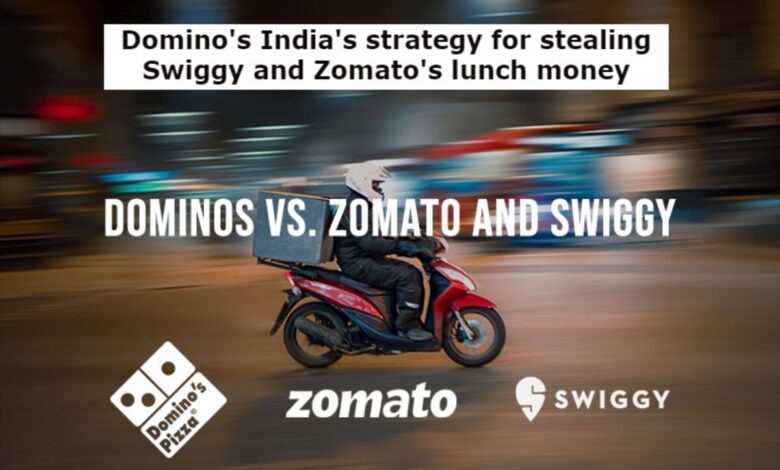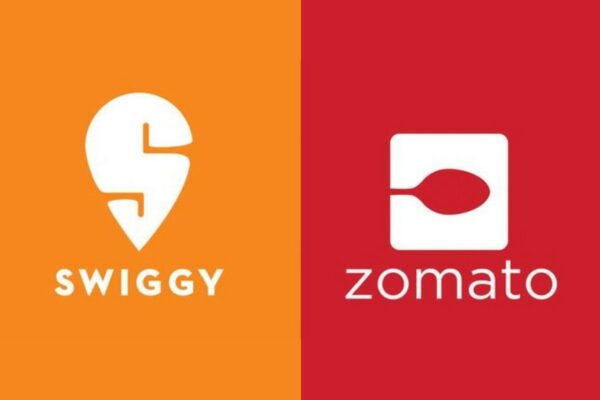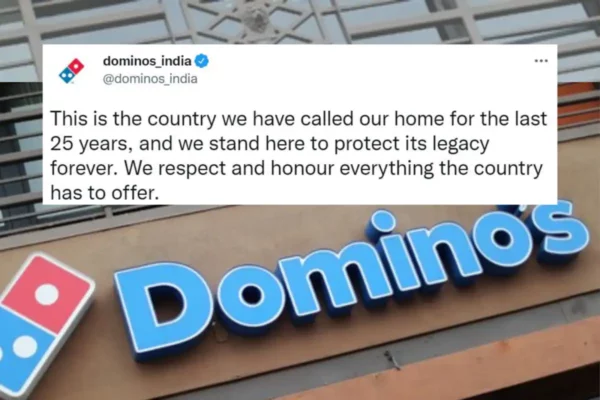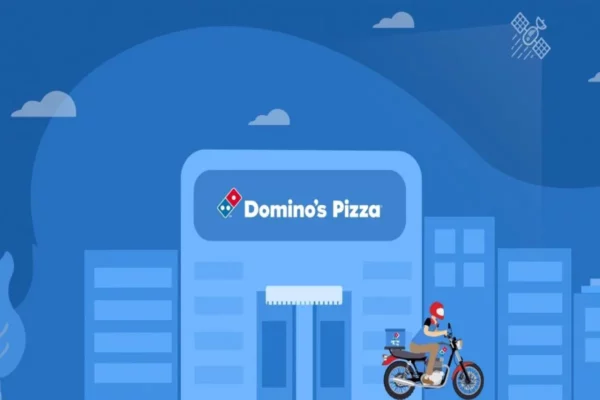Domino’s Strategy For Stealing Zomato And Swiggy’s Lunch Money

Domino’s strategy for stealing Swiggy and Zomato’s lunch money
Like most developing nations, India has developed into a centre for the delivery of pizza from companies like Pizza Hut, Smokin’ Joe’s, Laziz Pizza, Oven Story, Papa John’s, and others. Domino’s strategy for stealing Swiggy and Zomato’s lunch money
However, when it comes to a regular and devoted customer base, Domino’s Pizza is in a class of its own. Jubilant Foodworks established Domino’s Pizza India Private Limited in 1995, and the country’s first Domino’s Pizza location debuted there in 1996.
In the first quarter of 2014, Jubilant Foodworks inaugurated the 700th Domino’s Pizza location. In the next 24 months, they added another 300 locations, making India the second nation after the United States to reach the 1000-store milestone for Domino’s Pizza. In India, Jubilant Foodworks, which has been in operation for more than 25 years, has more than 1400 Domino’s Pizza locations.
The Domino’s India android app, released in 2012 amid the digitalization of the fast-food industry, has received 57 million downloads so far. Even though many dine-in options were available when Domino’s first opened in India, the business was already generating success through effective marketing initiatives.
With buy-one-get-one-free promotions and many other offers and discounts, it began to outpace its rivals even more quickly.
If Zomato and Swiggy’s commissions continue to increase, the Domino’s Pizza India franchise may consider taking some of their business away, according to the letter obtained by Reuters.

The information was revealed by Jubilant FoodWorks, which operates the Domino’s and Dunkin’ Donuts chains in India, in a private file with the Competition Commission of India (CCI), which is investigating allegations that Zomato and Swiggy behaved anti-competitively.
With more than 1,600 branded restaurant outlets, including 1,567 Domino’s and 28 Dunkin’ locations, Jubilant is India’s largest food services company.
The CCI ordered an inquiry into Zomato and Swiggy in April after an Indian restaurant group alleged preferential treatment, exorbitant commissions, and other anti-competitive practices. Food delivery services deny any improper behaviour.
This month, Jubilant responded to the watchdog’s request for information from the Domino’s India franchise and many other restaurants, saying that 26–27% of its overall business in India was generated via online platforms, including its mobile application and website.
In a letter dated July 19 addressed to the CCI, Jubilant indicated that it would “consider transferring more of its businesses from online restaurant platforms to the in-house ordering system in the event of an increase in commission fees.”
Food delivery platforms are becoming increasingly common in India thanks to the growing popularity of smartphones and the attractive discounts being offered. Jubilant’s warning comes as several Indian restaurants claim that Zomato and Swiggy’s purported actions have harmed their bottom line.
It goes without saying that Jubilant Foodworks, the Indian franchisee of Domino’s pizza business, wants to gradually reduce its reliance on online food delivery services like Zomato and Swiggy.
This was one of the main objectives of the firm’s recently created loyalty program, which rewards customers with a free pizza once they buy six of them, according to company management during an analyst call on July 28.
When asked why this partnership wasn’t restricted to Domino’s distribution channels, Jubilant CFO Ashish Goenka responded, “The primary idea of our loyalty program is to drive up order frequency and bring new customers to our brand.”
We’re making this an omnichannel program so customers may benefit from it regardless of where they sign up. However, the burn can only occur on our assets, which will increase traffic to those assets, he said.
In fact, any customer can qualify for the rewards of the loyalty program, even for orders conducted with Swiggy or Zomato. However, in order to take advantage of the offer, customers must place their orders through Domino’s channels, such as its app, website, or phone number.
The number of Domino’s app installs increased from 7.7 million to 8.3 million during the June quarter, according to the company’s Q1 financial release. In contrast, 97.7% of delivery sales were generated online, a modest decrease from the 97.9% recorded in March.
According to a Reuters story, Jubilant has informed the nation’s competition watchdog that if meal delivery apps Zomato and SoftBank-backed Swiggy continue to raise their fees, it may consider stealing some of their business.

According to industry insiders, the Domino’s franchise in India already has a more favourable arrangement with the food aggregators, with commission rates that are significantly lower than the typical 20–25 per cent threshold for other restaurants.
“We have not noticed any pressure, an increase in requests, or a change in the type of business permission we have with these platforms. According to Goenka, who spoke at the results call, “This has been our determined approach as we aim to transfer traffic more and more onto our assets, giving us better control and higher profitability.
The owner of a restaurant chain reported that it added 58 new locations in the June quarter, bringing the total number of locations to 1,625 outlets, continuing its strong store opening pace.
The firm, which also operates Dunkin Donuts in India, expanded its presence to 349 cities during the quarter by entering 12 new ones. Additionally, the business added two new locations, each for Popeyes and Hong’s Kitchen.
With a low foundation and outstanding revenue and operating results, the Domino’s Pizza master franchisee in India, Bangladesh, Sri Lanka, and Nepal reported a 63 per cent year-over-year increase in consolidated profit at Rs 112.6 crore for the quarter ending June 2022.
While the second COVID wave impacted the previous quarter, there was a 17.3 per cent sequential growth in the bottom line.
Even Domino’s considers the commissions from Zomato and Swiggy to be excessive.
Will Domino’s really stop working with Swiggy and Zomato in India?
According to Reuters, which saw a confidential document submitted by Jubilant FoodWorks, its India franchisee, to the Competition Commission of India, the pizza company is considering shifting some of its business away from the well-known food-delivery apps if their commissions are raised even higher (CCI).
The company wrote in its letter dated July 19 that it would “explore transferring more of its activities from online restaurant platforms to the in-house ordering system in the event of an increase in commission fees.”
The CEO of Zomato has stated that the commission prices won’t be decreasing any time soon, despite the restaurant aggregators’ silence on the matter. “We are not successful. We must find another source of income. Deepinder Goyal stated earlier this month that “rates are absolutely not going down.”
Restaurants’ protest against Zomato and Swiggy
Smaller restaurant operators have protested commission charges of up to 25 to 30 per cent over the years. These platforms might aid in logistics and discovery, but at what cost?
The alleged anti-competitive actions of Zomato and Swiggy became the subject of an investigation by India’s competition commission in April. The National Restaurant Association of India (NRAI), a group with more than 500,000 members, filed concerns, which prompted the investigation.
It might be simpler for Domino’s, which has 1,500 locations throughout India, to distance itself from these massive meal delivery companies than for smaller neighbourhood restaurants. Jubilant stated in February that its app had been downloaded more than 8 million times in the three months ending in December 2021.
Why does Domino’s India keep Zomato and Swiggy at bay, and how does it benefit the pizza chain?

Domino’s may excel at delivering pizzas to consumers’ doorsteps, but that skill serves solely as a vehicle. Its true goal is to increase pizza sales, which will result in a huge profit margin.
To increase the number of pizzas it sells, Domino’s frequently keeps its delivery prices low. We have to wonder if anyone else can make money from this if a firm with Domino’s level of data-driven expertise and delivery experience can’t.
Currently, it appears that delivery companies and their most enthusiastic supporters are placing their bets on the idea that customers will pay more for speedier delivery.
On the other hand, consumers already pay outrageous prices for these deliveries in the form of fees to delivery services, tips to their employees, and levies from restaurants that pay aggregators outrageous sums of money. The price disparity is substantial.
Domino’s refused to allow Swiggy and Zomato to deliver its pizzas since it is already concentrated on cultivating a devoted client base and has high volume deliveries. By selecting the button for third-party delivery aggregators, the company could capitalize on the outstanding benefits that McDonald’s turned down.
Zero commission fees
For each order placed through their platforms, Zomato and Swiggy charge the restaurants a commission of between 15 and 28 per cent. The order size, restaurant type, average order value, anticipated order volume, and delivery costs are only a few of the commissions dependent on actors.
This implies that if you order a Domino’s Pepperoni Pizza on Zomato for Rs. 500, you should expect to pay about Rs. 550.
Domino’s India would have been paying these food delivery aggregators millions of dollars daily for their approximately 2 lakh pizza deliveries. However, the business saved money by maintaining control of the delivery channels.
No revenue leakage
Despite the fact that technology can assist, Domino’s India avoids unwelcome account reconciliation problems by avoiding partnerships with Zomato and Swiggy. The entire procedure takes a lot of time, and the business uses this tactic to keep the top delivery companies away.
This is not to argue that third-party delivery services will cease to exist; they will continue. In general, if customers request a service, the market finds a way to deliver it.
However, the third-party delivery equation will need to be altered somehow. Domino’s India merely decided to do its deliveries because they are more profitable and can be supported by the demand for deliveries. Perhaps there has to be a change in expectations about the overall effect of third-party delivery.
However, Domino’s just struck an agreement with food tech giants Zomato and Swiggy. The company will now leverage the databases of both of these meal delivery aggregators to add to their wealth of knowledge because they have been employing big data to gain insights into client ordering patterns and other data.
By doing this, the business may expand into Zomato and Swiggy’s consumer bases while maintaining providing for its devoted clientele who prefer to place orders through phone or the Domino’s India app.
There are two lessons from Domino’s India that emerging businesses must learn.

Domino’s has relied on fundamental business principles and industry best practices to grow and develop its business. They have also promoted novel ideas that could end up as new best practices for entrepreneurs across all industries, not just the food sector.
Here are the key things we can take away from Domino’s surprising journey:
- Create a self-aware, motivated organization.
Domino’s is very aware of its brand. They stayed together for this main reason, even during the most challenging time, especially when Zomato entered the market. Domino’s consistently receives the highest repeat business because it has outlined its objectives and value propositions for customers. Domino’s India’s 20% of clients have accounted for almost 80% of its revenue.
- Use technology to accomplish what you can’t do single-handedly
Domino’s was altered by technology, which also offered them a competitive edge in the market. The American restaurant chain has invested heavily in technology in India. As a result, online sales now make up almost 30% of its revenue, or Rs. 250 crores, up from 16% the year before. Additionally, the company’s investment in digital marketing has increased significantly, from 5% in 2015 to 25% in 2021.
Domino’s journey to becoming the hero it is today has been long and difficult. Their recent turnaround and innovations are superb examples of how companies may overcome obstacles and integrate forward-thinking into their fundamental values.
edited and proofread by nikita sharma




